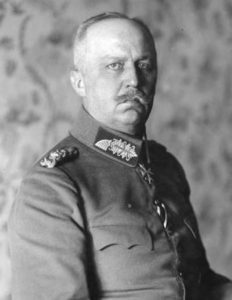Wednesday March 20th, 1918
Same. Two letters from home.
Germany’s plan for the Western Front
Nothing much doing today for either Frank or the broader Battalion. Things elsewhere however, particularly on the Western Front, are hotting up. Earlier this month, on March 3rd, the Bolsheviks signed the Treaty of Brest Litovsk. This formally liberated both the Central Powers from the Eastern Front and hundreds of thousands of their prisoners of war.

General Ludendorff, co-leader of the German war efforts, was keen to take advantage of this numerical supremacy and push for a decisive victory. The battleground was to be the Western Front. In his mind it was ‘now or never’: US troops were arriving in increasing numbers; the blockade was starving Germany of both food and the materials of war; and its allies were strained to their limits. AJP Taylor accepts all these arguments but then adds: ‘Most of all, Ludendorff was a general just like Haig; and could not resist the prospect of total victory…’¹
Ludendorff decided to attack on a broad front and use his elite force, the storm troopers, to lead the offensive, travelling light and relying on rapid re-supply from the rear. The artillery support tactics were for a creeping barrage: first a brief bombardment to disrupt HQ and communications; then to take out the artillery; and finally the front line infantry defences.
Britain readies its defence
With the German offensive in planning since November 1917 and a badly kept secret, the Allies had time to anticipate and respond: which they did in part. The British adopted the Germans’ ‘defence in depth’ strategy which had been used effectively to repulse British and French advances in 1917.². The strategy was to have three lines of defence; Small units of men would be on the front line or ‘forward zone’. Behind this was the ‘battle zone’ – out of the range of German field artillery – where the offensive would be challenged most fiercely. The last line or ‘rear zone’ was where reserves would be held to counter-attack or stop further incursions.
‘Rather than defeating an attacker with a single, strong defensive line, defence in depth relies on the tendency of an attack to lose momentum over a period of time or as it covers a larger area. A defender can thus yield lightly defended territory in an effort to stress an attacker’s logistics or spread out a numerically superior attacking force. Once an attacker has lost momentum or is forced to spread out to pacify a large area, defensive counter-attacks can be mounted on the attacker’s weak points with the goal being to cause attrition warfare or drive the attacker back to its original starting position.’³
From theory to practice
All this is ahead for both Armies. The Spring Offensive begins tomorrow.
13th (Service) Battalion War Diary – 20th March 1918 – No 1 Sector, Olasli
Training as per Programme. The GOC 12th Corps visited the Battalion at training during the forenoon. 1 OR struck off under GRO 1011 with effect from 20-3-18.
References & Further Reading
¹ ‘The First World War: An Illustrated History’ by AJP Taylor (Penguin). Kindle location 2190.
² ‘Spring Offensive‘ in Wikipedia
³ ‘Defence in Depth‘ – History of WWI in LivingWarBirds.com
* German National Archives


